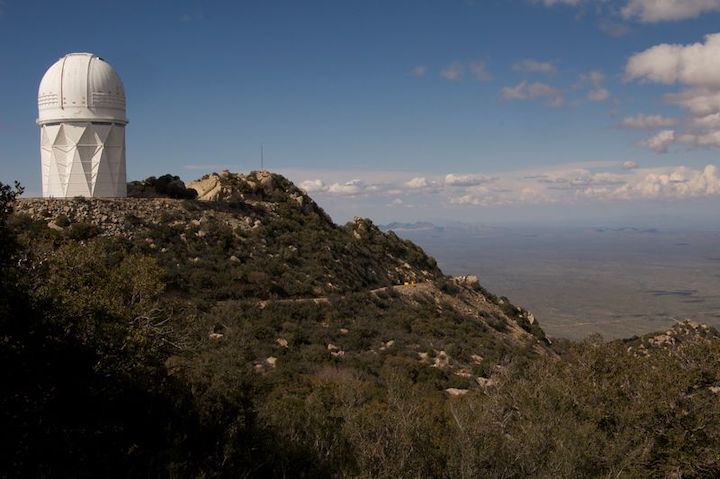13.08.2019
A telescope in Arizona will conduct the largest spectroscopic survey of galaxies.

The Mayall 4-meter Telescope at Kitt Peak National Observatory near Tucson.Credit: Credit: John Briley for The Washington Post/Getty
Astronomers are about to embark on their most ambitious galaxy-mapping project ever. Over the next five years, they will use a telescope in Arizona — retrofitted with thousands of small robotic arms — to capture light spectra from 35 million galaxies and reconstruct the Universe’s history of expansion. Their main aim: to elucidate the nature of dark energy, the enigmatic force that is pushing the Universe to accelerate at an ever-faster pace.
The Dark Energy Spectroscopic Instrument (DESI) is scheduled to see ‘first light’ in September. After a commissioning period, its survey of the northern sky — using the Mayall 4-meter Telescope at Kitt Peak National Observatory near Tucson — could start as early as January 2020. Roughly three-quarters of DESI’s US$75-million budget comes from US Department of Energy (DOE), with major contributions from the United Kingdom and France.
DESI is the first in a new generation of experiments investigating the past expansion of the Universe, which come two decades after the first strong evidence of dark energy was found in 1998. Others include ground-based and space observatories set to come online in the 2020s.
The survey will reconstruct 11 billion years of cosmic history. It could answer the first and most basic question about dark energy: is it a uniform force across space and time, or has its strength evolved over eons?
The survey will track cosmic expansion by measuring features of the early Universe, known as baryon acoustic oscillations (BAOs). These oscillations are ripples in the density of matter that left a spherical imprint in space around which galaxies clustered. The distribution of galaxies is highest in the centre of the imprint, a region called a supercluster, and around its edges — with giant voids between these areas.
Primordial pattern
Superclusters formed in regions where dark matter — invisible material that drives the formation of such large-scale structures — had concentrated under its own gravitational pull.
This primordial pattern of galaxy clustering has remained unchanged since about one million years after the Big Bang. As the Universe grew, BAOs have tracked its expansion; they are now about 320 megaparsecs wide (1 billion light years). Cosmologists use this distance as a ruler; by tracking the size of the BAOs across time, they can reconstruct how the Universe itself expanded.
“The pattern in the map is basically constant; the scale is increasing,” says Daniel Eisenstein, a physicist at Harvard University in Cambridge and a spokesperson for DESI.
Tracking BAOs requires a 3D map of galaxies made by measuring their redshifts — the lengthening of the electromagnetic waves in their spectra of light. Redshifts measure how fast a galaxy is receding from the Milky Way, which indicates how far away that galaxy is.
The more redshifts that are measured, the more precise the BAO tracking. Eisenstein and others have found the unmistakable BAO signature in previous galaxy surveys, in particular the US-based Baryon Oscillation Spectroscopic Survey (BOSS), which ended in 2014, and the Australia-based Two-degree-Field Galaxy Redshift Survey, which finished in 2002. Together, those surveys mapped nearly 2.4 million galaxies.
The number of galaxies that DESI will track will eclipse the previous surveys by an order of magnitude. “Within a few months, we will surpass what we had for BOSS,” says Michael Levi, a physicist at the Lawrence Berkeley National Laboratory in California and the director of DESI.
Robot retrofit
DESI will achieve such a speedup thanks to a radically different design. Surveys such as BOSS used optical fibres, placed into holes drilled into custom metal plates, to capture each galaxy’s light and deliver it to a separate spectrograph to measure the redshift. But the plates needed to be changed to measure each different part of the sky, which was slow and cumbersome.
DESI will speed up this process by replacing the metal plates with 5,000 tiny robotic arms, arranged in a closely packed beehive pattern. Once images of galaxies are projected on the focal plane of the telescope — each about 100 micrometres wide — the robotic arms will quickly position optical fibres to within 10 micrometres of the centre of each image, explains Joseph Silber, a mechanical engineer at LBNL who led the design and construction of the robotic system.
Although BOSS typically changed about five plates per night, DESI’s focal plane can be refigured for another part of the sky in a few minutes; the main limitation is how long the exposures need to be to get enough light. Depending on the season and the weather, DESI might be able to take 30 or more exposures, each with thousands of redshifts, in a single night.
A few other astronomy experiments, including the Large Sky Area Multi-Object Fibre Spectroscopic Telescope at the Xinglong Station in China, have used robotic positioners before. But, Silber says, “DESI is definitely the biggest one tried so far.”
In addition to probing dark energy, DESI will study the role of dark matter in the growth of galaxies and clusters of galaxies by measuring motion in clusters, says DESI spokesperson Nathalie Palanque-Delabrouille, a cosmologist at the French Alternative Energies and Atomic Energy Commission (CEA) Saclay Research Centre outside Paris. This will provide “exquisite tests” of the current favourite models of how dark matter drives large-structure growth, she says, versus alternatives that explain the formation of these structures by tweaking Albert Einstein’s general theory of relativity.
Quelle: nature

